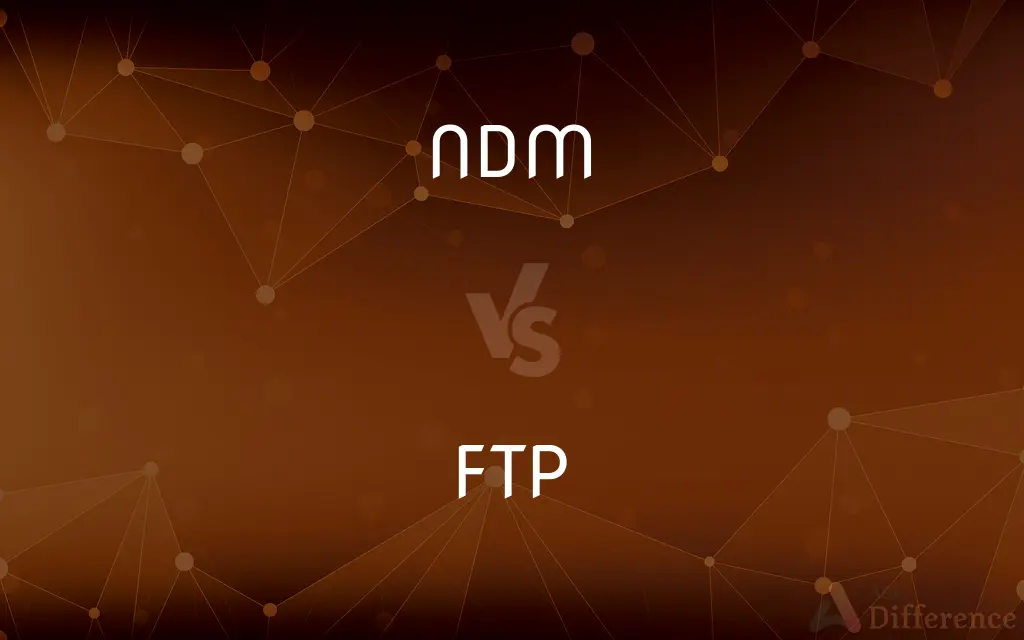NDM vs. FTP — What's the Difference?
By Tayyaba Rehman — Published on December 24, 2023
NDM (Network Data Mover) is a secure file transfer protocol mainly for mainframe systems, while FTP (File Transfer Protocol) is a standard internet protocol for transferring files between computers.

Difference Between NDM and FTP
Table of Contents
ADVERTISEMENT
Key Differences
NDM, known as Network Data Mover, is a protocol specifically designed to ensure the secure and reliable transfer of data, particularly between mainframe systems. FTP, or File Transfer Protocol, is a widely-adopted protocol for moving files across the internet and does not inherently focus on security.
NDM provides a robust level of security and is often chosen for business-critical transfers, ensuring data integrity and confidentiality. FTP, on its own, doesn’t encrypt data, making it susceptible to eavesdropping, but its secure version, SFTP, adds encryption to address this.
When considering speed and efficiency, NDM stands out for its ability to manage large transfers and prioritize them based on business needs. FTP, however, is more straightforward, primarily dealing with the simple act of moving files from one location to another.
Implementation-wise, NDM can be complex, especially when integrating with modern infrastructure due to its mainframe origins. FTP is more universally understood and can be easily implemented across various platforms.
To summarize, NDM is a robust, secure protocol best suited for specific business environments, particularly mainframes. In contrast, FTP is a general-purpose file transfer protocol, widely used but with inherent security vulnerabilities.
ADVERTISEMENT
Comparison Chart
Primary Use
Mainly for mainframe systems
Universal file transfer
Security Focus
High with data integrity and confidentiality
Low (though SFTP offers encryption)
Implementation Complexity
Can be complex
Generally straightforward
Speed and Efficiency
Manages large transfers effectively
Simple file transfer
Encryption
Built-in
Available in SFTP version
Compare with Definitions
NDM
NDM ensures secure data transfers.
Banks often use NDM to move sensitive financial data.
FTP
FTP operates without inherent encryption.
To ensure security, many have transitioned from FTP to SFTP.
NDM
NDM can manage and prioritize large data transfers.
In a data migration project, NDM can be instrumental in transferring massive datasets.
FTP
FTP is an internet protocol for file transfers.
Websites often use FTP to upload or download content.
NDM
NDM is a protocol designed for business-critical transfers.
For mission-critical operations, businesses might opt for NDM over other transfer methods.
FTP
FTP is suitable for basic file transfer needs.
For transferring holiday photos to a personal server, FTP might suffice.
NDM
NDM emphasizes data integrity and confidentiality.
When transferring legal documents, companies might prefer NDM for its security features.
FTP
FTP allows file transfer between computers on a network.
Developers might use FTP to move code files to a server.
NDM
NDM is optimized for mainframe environments.
Large corporations with legacy systems rely on NDM for data transfers.
FTP
FTP is platform-independent and widely adopted.
Most operating systems come with built-in FTP client capabilities.
FTP
A communications protocol governing the transfer of files from one computer to another over a network.
FTP
To transfer (a file) using FTP.
FTP
To transfer a file using FTP.
FTP
An acronym for file transfer protocol, a standardized protocol used to allow transmission of files between computers; as, send me the file by ftp. It consists of a set of coded signals which are transmitted between computers, and which inform the receiving computer of the nature of a packet of information to be transmitted, and inform the transmitting computer when a packet has been successfully received.
FTP
To send from one computer to another by means of the standard file transfer protocol (ftp); as, he ftp'd me the file yesterday.
FTP
Protocol that allows users to copy files between their local system and any system they can reach on the network
FTP
Use the File Transfer Protocol to transfer data from one computer to another;
You can FTP these data
Common Curiosities
What does NDM stand for?
NDM stands for Network Data Mover.
Can FTP be used for transferring files over the internet?
Yes, FTP is a standard protocol for transferring files over the internet.
For which environments is NDM particularly suited?
NDM is optimized for mainframe environments.
Is FTP secure for file transfers?
Standard FTP is not encrypted, but its variant, SFTP, offers secure file transfers.
How does NDM ensure the prioritization of transfers?
NDM has features to manage and prioritize large and business-critical data transfers.
Are there modern alternatives to NDM for secure transfers?
Yes, there are several modern protocols like HTTPS and SFTP that offer secure transfers, but NDM remains a choice for specific environments.
Is FTP complex to set up?
FTP is generally straightforward to set up and is widely supported.
Can I use FTP with any operating system?
FTP is platform-independent and can be used with most operating systems.
What kind of businesses might benefit most from using NDM?
Large corporations with legacy mainframe systems often benefit from NDM.
Does NDM encrypt data during transfers?
Yes, NDM ensures data encryption, integrity, and confidentiality.
Are there alternatives to FTP for secure transfers?
Yes, SFTP and SCP are secure alternatives to standard FTP.
Can I use FTP for transferring personal files?
Yes, but for security reasons, it's better to use secure variants like SFTP.
Which is faster, NDM or FTP?
It depends on the specific scenario, but NDM is designed to manage large transfers effectively, while FTP is more basic.
Does NDM work well with modern infrastructure?
NDM can be complex to integrate with modern infrastructure due to its mainframe origins.
What are the inherent vulnerabilities of FTP?
The primary vulnerability is its lack of encryption, making data susceptible to eavesdropping.
Share Your Discovery

Previous Comparison
Unsaturated Solutions vs. Saturated Solutions
Next Comparison
RDRAM vs. SDRAMAuthor Spotlight
Written by
Tayyaba RehmanTayyaba Rehman is a distinguished writer, currently serving as a primary contributor to askdifference.com. As a researcher in semantics and etymology, Tayyaba's passion for the complexity of languages and their distinctions has found a perfect home on the platform. Tayyaba delves into the intricacies of language, distinguishing between commonly confused words and phrases, thereby providing clarity for readers worldwide.
















































